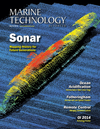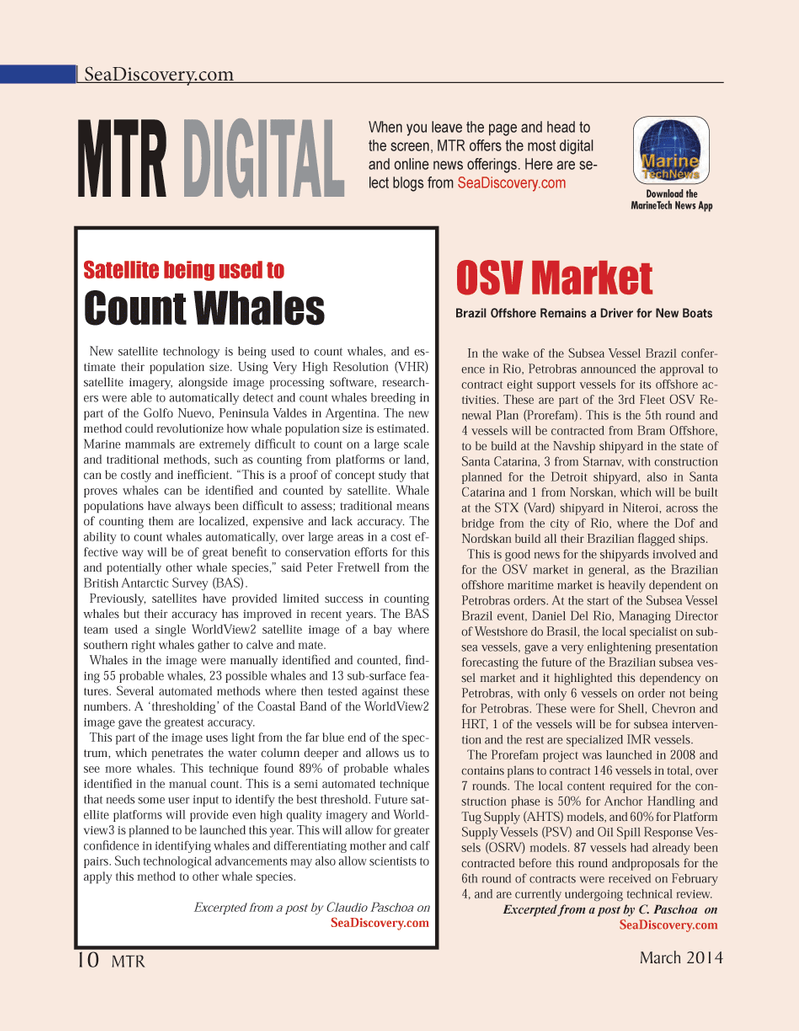
Page 10: of Marine Technology Magazine (March 2014)
Instrumentation: Measurement, Process & Analysis
Read this page in Pdf, Flash or Html5 edition of March 2014 Marine Technology Magazine
SeaDiscovery.com MTR DIGITAL When you leave the page and head to the screen, MTR offers the most digital and online news offerings. Here are se- lect blogs from SeaDiscovery.com Download the MarineTech News App In the wake of the Subsea Vessel Brazil confer- ence in Rio, Petrobras announced the approval to contract eight support vessels for its offshore ac- tivities. These are part of the 3rd Fleet OSV Re- newal Plan (Prorefam). This is the 5th round and 4 vessels will be contracted from Bram Offshore, to be build at the Navship shipyard in the state of Santa Catarina, 3 from Starnav, with construction planned for the Detroit shipyard, also in Santa Catarina and 1 from Norskan, which will be built at the STX (Vard) shipyard in Niteroi, across the bridge from the city of Rio, where the Dof and Nordskan build all their Brazilian ß agged ships. This is good news for the shipyards involved and for the OSV market in general, as the Brazilian offshore maritime market is heavily dependent on Petrobras orders. At the start of the Subsea Vessel Brazil event, Daniel Del Rio, Managing Director of Westshore do Brasil, the local specialist on sub- sea vessels, gave a very enlightening presentation forecasting the future of the Brazilian subsea ves- sel market and it highlighted this dependency on Petrobras, with only 6 vessels on order not being for Petrobras. These were for Shell, Chevron and HRT, 1 of the vessels will be for subsea interven- tion and the rest are specialized IMR vessels. The Prorefam project was launched in 2008 and contains plans to contract 146 vessels in total, over 7 rounds. The local content required for the con- struction phase is 50% for Anchor Handling and Tug Supply (AHTS) models, and 60% for Platform Supply Vessels (PSV) and Oil Spill Response Ves- sels (OSRV) models. 87 vessels had already been contracted before this round andproposals for the 6th round of contracts were received on February 4, and are currently undergoing technical review. Excerpted from a post by C. Paschoa on SeaDiscovery.com Satellite being used toCount WhalesNew satellite technology is being used to count whales, and es- timate their population size. Using Very High Resolution (VHR) satellite imagery, alongside image processing software, research- ers were able to automatically detect and count whales breeding in part of the Golfo Nuevo, Peninsula Valdes in Argentina. The new method could revolutionize how whale population size is estimated. Marine mammals are extremely difÞ cult to count on a large scale and traditional methods, such as counting from platforms or land, can be costly and inefÞ cient. ÒThis is a proof of concept study that proves whales can be identiÞ ed and counted by satellite. Whale populations have always been difÞ cult to assess; traditional means of counting them are localized, expensive and lack accuracy. The ability to count whales automatically, over large areas in a cost ef- fective way will be of great beneÞ t to conservation efforts for this and potentially other whale species,Ó said Peter Fretwell from the British Antarctic Survey (BAS). Previously, satellites have provided limited success in counting whales but their accuracy has improved in recent years. The BAS team used a single WorldView2 satellite image of a bay where southern right whales gather to calve and mate. Whales in the image were manually identiÞ ed and counted, Þ nd-ing 55 probable whales, 23 possible whales and 13 sub-surface fea- tures. Several automated methods where then tested against these numbers. A ÔthresholdingÕ of the Coastal Band of the WorldView2 image gave the greatest accuracy. This part of the image uses light from the far blue end of the spec- trum, which penetrates the water column deeper and allows us to see more whales. This technique found 89% of probable whales identiÞ ed in the manual count. This is a semi automated technique that needs some user input to identify the best threshold. Future sat-ellite platforms will provide even high quality imagery and World- view3 is planned to be launched this year. This will allow for greater conÞ dence in identifying whales and differentiating mother and calf pairs. Such technological advancements may also allow scientists to apply this method to other whale species.Excerpted from a post by Claudio Paschoa on SeaDiscovery.com OSV MarketBrazil Offshore Remains a Driver for New Boats March 2014 10 MTRMTR #2 (1-17).indd 10MTR #2 (1-17).indd 102/24/2014 10:06:13 AM2/24/2014 10:06:13 AM

 9
9

 11
11
